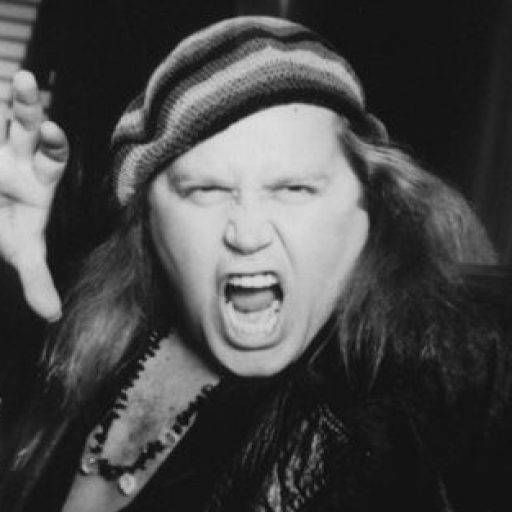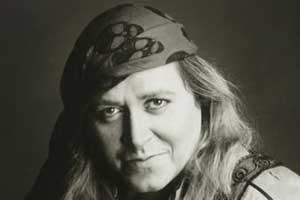By Lawrence Christon
Times Staff Writer
Originally printed in The Los Angeles Times
Monday, April 13, 1992
His piercing anger, protest now will never know a resolution we can share
None of the TV anchors knew quite what to make of Sam Kinison when news of his death came over the wire early Saturday morning. “The loud comedian,” most of them called him, struggling to make do with a meaninglessly vague adjective, then running a silent interview clip in which, with brushed shoulder-length blond hair and faintly rubicund face, he looked like an amiable Friar Tuck dispensing words of comfort and reassurance to his unseen listener.
If anything, Kinison was a manifestation of acute discomfort, and that’s why he’s remembered, even if TV’s public memory is shrouded with incomprehension.
The circumstance of his death–a head-on auto collision with an allegedly drunk driver speeding along the wrong side of a highway double line–may well have made the news on the strength of its spectacular brutality regardless of who the victim was. Obviously, Kinison made the top of the hour because he was a celebrity of sorts, a famous comedian, a show-biz person. But there’s more. While it’s saddening to see any career cut down before its arc has been completed, Kinison represents unfinished business, a piercing howl of anger and protest that now will never know a resolution we can share.
There’s no denying he was a base figure. Sam Kinison came along in the mid-’80s as a shock trooper of the American subconscious. On top, we had the sunny Reagan presidency and its fond avuncular approval of the get-rich-quick ethos–BMWs and lucrative paper chases for insiders and the thirtysomething crowd, and “Morning in America” promises for the rest of the electorate left holding its hand out. Hidden underneath, we had the palpable beginning of what now festers in abundance: urban rot, virulent racial and ethnic division, sexual rage, the dumbing-down of the young, the relentless commercial manipulation of our modern social coin–the public image.
Kinison planted his squat legs like a fierce troll by a bridge, skewed his face into a florid rage, and screamed. That was his act. There was no pretense of comedic refinement, of structure and build and the bait-and-switch line that is comedy’s stock in trade. A Sam Kinison joke didn’t hit the media wire and zip through the country like one of Johnny Carson’s political zingers. It was usually crude, misogynistic, homophobic or wrongheaded–for a while he was the most aggressively misinformed comedian of his generation when it came to understanding AIDS.
Nor was his fury particularly new. “Network’s” irate Howard Beale galvanized the country in 1977 with the line, “I’m as mad as hell and I’m not going to take this anymore.” In the ’60s, what else could you hear first in Jimi Hendrix’s rhythmically twisted “Star-Spangled Banner” but dizzying distress? In the ’50s, Allen Ginsberg delivered “Howl” and William Burroughs gave us the precursor to the primal scream–the sensation of waking up in the morning with thick petroleum jelly smeared on your lips.
But Kinison was a creature of the ’80s’ excesses and frustrations. His alcohol and drug habit were common knowledge, and he tried to do what the other prevailing wild things did. He made record albums (“Louder Than Hell” and “Have You Seen Me Lately?”). He made a stab at the movies (Rodney Dangerfield’s “Back to School” and the aborted “Atuk”). He appeared on TV’s “Saturday Night Live” and “Late Night With David Letterman” and was an MTV regular. He also played Tim Matheson’s conscience on Fox-TV’s “Charlie Hoover.”
But he really wasn’t cut out for anything other than live performance (he was driving to a gig when he was killed), and his wrestling with Jessica Hahn on his “Wild Thing” video seemed a damning symbol of the visible degradation some people will endure to achieve celebrity. Watching that video, you couldn’t tell if he was making a statement or if he was trying to see how far he could fall.
Comedians are the shrewdest judges of each other’s talent. It’s telling that none of his peers begrudged him his success. “He’s honest,” you’d hear them say. Or, “You may not like his material, but it comes out of a core of real conviction.” The comic they name as his ostensible colleague but de facto opposite, the figure they generally disdain as a phony, is Andrew Dice Clay.
Kinison was the unhappy son of an impoverished Pentecostal minister in Peoria, Ill., and for a while became a minister himself before he married (at 21) and divorced (at 25), and then gave up the calling (“I was getting too hip for the room,” he told an interviewer). He married and divorced yet again. Years later, one of his brothers committed suicide. His spiritual and sexual pain formed an underlying emotional truth that carried him a lot farther into his audience’s sixth sense than did his actual comment. There are times when it all gets to be too much, when there’s nothing to do but scream. For that, he was the man of the hour.
It’s impossible to tell now if Kinison would ever have been able to get out of the shockmeister ’80s, when he made this statement: “I’m so tired of men who’re afraid to hurt women’s feelings. Then you turn on the tube and you watch somebody like Roseanne Barr or Joan Rivers who just slam men: ‘Men are jerks . . . losers’ and we’re supposed to stand around and act like women are perfect.” It needed to be said then, but cannot with good conscience be said now, not after the Clarence Thomas-Anita Hill hearing. And where that primal scream once seemed tonic and even cathartic, now it would only unnerve us as we make our way through the white noise of everyday anxiety and urban terror.
Who can tell? He was capable of enlightenment, and maybe his new marriage might have brought him the peace he never knew. But the violence of his end is particularly haunting: a troubled man meeting a senseless, smoldering end on a strip of desert highway under a half-moon. His was a peculiarly American story.

